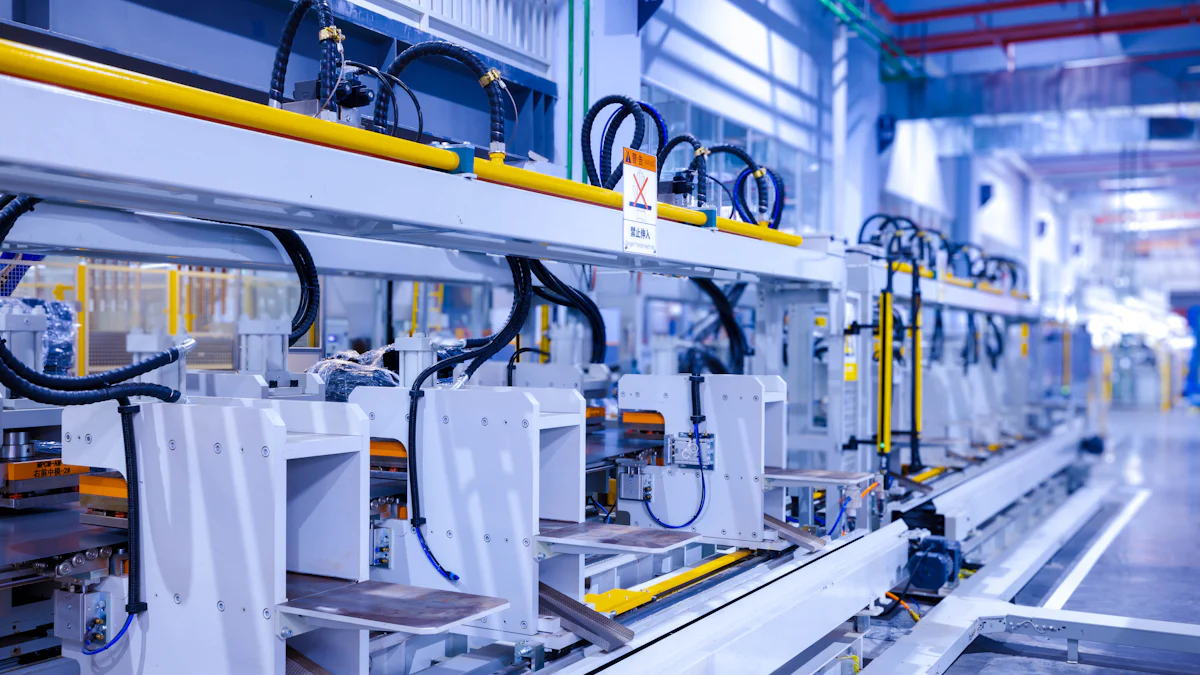Key Innovations in Manufacturing for 2024

Innovation drives the manufacturing industry forward. Rapid technological advancements reshape manufacturing processes. The integration of AI, IoT, and robotics enhances efficiency and productivity. Automation standardizes processes and provides valuable data insights for decision-making. Machines now handle repetitive tasks, freeing workers for more complex roles. The market for enterprise IT services in manufacturing reached $414.5 billion in 2022, with a projected CAGR of over 9% from 2022 to 2027. These latest manufacturing advances set the stage for significant developments in 2024.
Latest Manufacturing Advances

Advanced Automation and Robotics
Collaborative Robots (Cobots)
Manufacturers now employ collaborative robots, known as cobots, to work alongside human workers. Cobots enhance safety and efficiency in manufacturing environments. These robots quickly learn and adapt through observation. Cobots handle tasks that are dirty, dangerous, or monotonous. This shift towards intelligent, collaborative automation signifies a significant advancement in the sector.
Jo Debecker, an expert from Wipro, states, "AI and advancements in sensory technology have spurred the adoption of cobots in manufacturing, enhancing safety and teamwork with humans."
Autonomous Mobile Robots (AMRs)
Autonomous Mobile Robots (AMRs) revolutionize material handling in factories. AMRs navigate complex environments without human intervention. These robots use advanced sensors and AI algorithms to optimize routes and avoid obstacles. AMRs increase productivity by reducing manual labor and minimizing errors. The integration of AMRs represents a leap forward in manufacturing automation.
Smart Manufacturing and Industry 4.0
Internet of Things (IoT)
The Internet of Things (IoT) connects machines, devices, and systems within manufacturing facilities. IoT enables real-time monitoring and data collection. Manufacturers use IoT to optimize production processes and improve decision-making. IoT enhances predictive maintenance, reducing downtime and operational costs. The adoption of IoT drives significant improvements in manufacturing efficiency.
Digital Twins
Digital twins create virtual replicas of physical assets and processes. Manufacturers use digital twins to simulate and analyze production scenarios. This technology helps identify potential issues before they occur. Digital twins enable continuous improvement and innovation in manufacturing. The implementation of digital twins marks a pivotal development in smart manufacturing.
Sustainable Manufacturing Practices
Green Technologies
Green technologies focus on reducing environmental impact in manufacturing. Manufacturers adopt renewable energy sources and energy-efficient systems. Green technologies minimize waste and lower carbon emissions. These practices align with global sustainability goals. The commitment to green technologies demonstrates a responsible approach to manufacturing.
Circular Economy Models
Circular economy models promote resource efficiency and waste reduction. Manufacturers design products for durability, reuse, and recycling. Circular economy models extend the lifecycle of materials and products. These practices reduce the need for raw materials and decrease environmental impact. The adoption of circular economy models signifies a shift towards sustainable manufacturing.
Advanced Materials and Additive Manufacturing
3D Printing Innovations
3D printing, also known as additive manufacturing, revolutionizes production processes. Manufacturers use 3D printing to create complex geometries that traditional methods cannot achieve. This technology reduces material waste and shortens production times. Companies can quickly prototype and iterate designs, leading to faster innovation cycles. The aerospace and automotive industries benefit significantly from 3D printing. These sectors produce lightweight and durable components more efficiently.
Steve Richmond from Projetech states, "Automation and robotics are elevating manufacturing to the next level by eliminating a lot of human labor—especially tasks that are dirty, dangerous or monotonous."
The medical field also sees advancements through 3D printing. Custom prosthetics and implants tailored to individual patients improve healthcare outcomes. The versatility of 3D printing extends to consumer goods, where personalized products meet specific customer needs. The continuous development of new materials for 3D printing broadens its applications. Innovations in this area promise to transform manufacturing landscapes.
Nanotechnology
Nanotechnology introduces groundbreaking changes to material science. This technology manipulates matter at the atomic and molecular levels. Manufacturers use nanomaterials to enhance product properties such as strength, durability, and conductivity. The electronics industry benefits from nanotechnology by producing smaller and more efficient components. These advancements lead to more powerful and compact devices.
Nanotechnology also plays a crucial role in sustainable manufacturing. Coatings with nanomaterials improve energy efficiency and reduce environmental impact. The automotive industry uses nanotechnology to develop lighter and stronger materials, improving fuel efficiency. In healthcare, nanotechnology enables targeted drug delivery systems, enhancing treatment efficacy.
Jo Debecker from Wipro highlights, "AI and advancements in sensory technology have spurred the adoption of cobots in manufacturing, enhancing safety and teamwork with humans."
The potential of nanotechnology extends to various sectors, driving innovation and efficiency. The integration of nanotechnology in manufacturing processes represents a significant leap forward. As research progresses, new applications and materials will continue to emerge. The future of manufacturing lies in harnessing the power of nanotechnology.
Key innovations in manufacturing for 2024 include advanced automation, smart manufacturing, sustainable practices, and cutting-edge materials. Collaborative robots and autonomous mobile robots enhance efficiency and safety. IoT and digital twins drive real-time monitoring and continuous improvement. Green technologies and circular economy models promote sustainability. 3D printing and nanotechnology revolutionize production processes and material science.
These advancements will transform the manufacturing industry, increasing productivity and reducing environmental impact. Future trends will likely focus on further integrating AI and immersive technologies, driving even greater innovation and efficiency beyond 2024.
See Also
A Comprehensive Manual for Attaining Manufacturing Success with Supply Chain Strategies in 2024
The Pathway to Achieving Manufacturing Success through Essential Strategies
Efficient Approaches for Addressing Supply Chain Challenges in High-Tech Manufacturing
Guiding Through Lean Logistics for Achieving Success in High-Tech Manufacturing
Collaborative Innovation: Strengthening Supplier Partnerships in High-Tech Manufacturing
